Through The Lens at the Navajo Nation Museum
 My dear friend Mely Mitchell is one of the artists in the upcoming exhibition Through The Lens, a photographic examination of historical and contemporary Navajo culture.
My dear friend Mely Mitchell is one of the artists in the upcoming exhibition Through The Lens, a photographic examination of historical and contemporary Navajo culture.
This show will be at the Navajo Nation Museum in Window Rock, Arizona from August 28 through March 27 2010.
Yay Mely!
I Get Interviewed
A nice young lady from Rogers State University interviewed me some months ago. Here's what I told her. What did it take to get to your position?
The short answer is: hard work, believing in myself, and a healthy dose of good luck. The long answer follows.
I was born in Norman, Oklahoma, in 1980. When I was still a baby, my family moved to Albuquerque, New Mexico, where we lived for the next twenty years. My parents both have backgrounds in the arts. My father, John Atlee, was a professional potter when I was born. Since then he has practiced in a number of other media. My mother, Emmy Ezzell, studied art in college and became a book designer a couple of years before I came along. She is now Production Director at the University of Oklahoma Press in Norman.
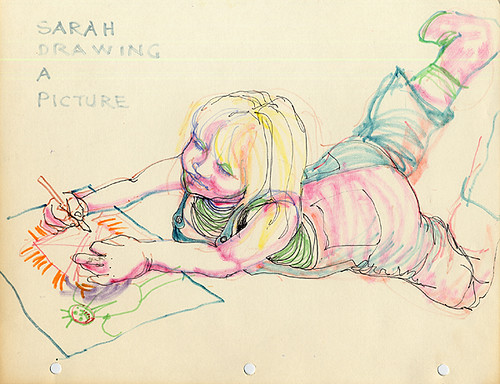
Sarah's Mom Draws Sarah Drawing, ink on paper, circa 1984 by Emmy Ezzell. Click image to view full-size.
I am not alone in believing that all children are artists, and the lucky ones who are encouraged continue to be artists when they grow up. My parents have always understood the value of art in a person's life, so while growing up I knew that making art was not silly or wasteful.
By the time I graduated from high school I knew that I wanted to study art in college. I didn't yet know if I wanted to pursue fine art as a profession, because I knew that career path was a difficult one with no guarantee of success.
I attended the University of New Mexico on scholarship. I majored in Fine Art Studio with a focus in painting, and graduated in 2001. [See that gif on the Art Studio program page? The barest hint of my worktable is visible in it, behind James Pitt's paintings. Yeah, looks like they haven't updated it lately.] My education at UNM focused mostly on the conceptual side of art rather than the technical. I feel I got a very good education in how to think and talk like an artist. But while I was there, my desire to produce technically excellent drawings and paintings was met with confusion and occasionally discouragement. The practice of making pictures of things was definitely not the norm at UNM.
I understood that I didn't really fit in at this program, but I set my sights on what I really wanted to make. You may be familiar with Juxtapoz magazine, which entirely changed the way I looked at art. (At that time, most of the students and faculty at UNM hadn't yet heard of Juxtapoz.) I spent a lot of Friday nights in the studio, alone, trying to make paintings that were as good as just one frame of Batman: Arkham Asylum
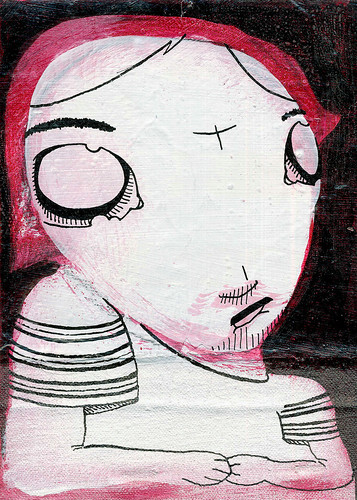
Jaded Girl, acrylic and ink on canvas, 5 x 7 inches, 2001. Click image to see more of these.
I spent the next two years out of school, living in Bloomington, Indiana. (My Mom had moved there for a new job following my parents' divorce.) I kept painting, and I booked a few gallery shows around town. I did some part-time work, but mainly my Mom supported me during that time. My paintings were not what I wanted them to be. I realized that I didn't have the skills, guidance, or enough practice to be the painter I wished I was. I decided to go back to school.
In 2003, I enrolled at the Rochester Institute of Technology (Rochester, New York) as a graduate student. RIT is a technical university, but they have very good programs in the arts. I majored in painting, minored in illustration, and graduated in 2006 with a Master of Fine Arts degree. My graduate thesis was about the use of cartoons in contemporary painting.
[I'd like to interject here and say that going to graduate school was frighteningly expensive. Most art students enter grad school intending to become professors. This never interested me; I was in it to become a better painter. I did that. It was worth it. But I also racked up student loans that are too big to talk about here. So if you are an art student considering grad school, please don't feel like you need to rush into that. It is not your only option.]
While at grad school, I learned from one of my professors that being a professional illustrator was a viable career choice. Thousands of illustrators are employed every day by magazines, book publishers, companies who need images to sell their products, etc. Turns out, illustration is everywhere once you start looking for it. Every time you see a picture, remember that *someone was paid to make that picture.* And it's not all made on computers, either.

Birthe Flexner's Coffee Cups, ink sketch, 2008. Click image to view source.
Upon getting my master's degree I hoped to become a professional illustrator. In 2005, my Mom had returned to Norman, Oklahoma, for a new job. I followed her there, eager to reconnect with my Okie roots. What I found when I got here surprised me. Oklahoma has a growing, thriving contemporary art community, made up of people of all ages and backgrounds. As an artist, I was welcomed with open arms.
Of course, there were a couple of proactive steps I took to help myself along. I joined the Oklahoma Visual Arts Coalition and sent them a portfolio to put up on their website. I cannot emphasize enough how important a resource this is for Oklahoma artists. (JOIN.) Julia Kirt, the Director of OVAC, looked at my portfolio and offered me a slot in an upcoming group show. Ashley Griffith, a photographer and gallery owner in OKC, went to that show, and offered me a show at her gallery. Meanwhile, I also submitted my portfolio to Mainsite Gallery in Norman. They offered to put my work in their annual Emergent show. That was in late 2006, and things have just snowballed from there. In art, as in any other industry, word of mouth is the best advertising.
I believe that talent exists, but by no means is it the deciding factor in a person's success. I do believe that luck favors the prepared. I have been blessed with many opportunities. Certain professional skills have helped me take advantage of those opportunities: having a website where people can see my work, having a quality portfolio (on the web, on cd, and in book form), having business cards, returning people's calls, sending thank-you notes, shaking hands, being willing to ask for advice and learn from other people. These kinds of things apply to every business, not just art, and they matter just as much as the paintings I produce.
My current job title is gallery artist, or working artist. I never thought it would happen, but I've become an artist who shows work in galleries (and even sells some). I don't hesitate to say that living in Oklahoma has helped to bring this about.

Submerge, acrylic on canvas, 2009. Click image to view source.
What do you like about your job?
I love that I get to follow my calling. I make art, and nobody gets to tell me what that art should look like. I have complete creative control over my product. I have a fantastic network of support and mutual creativity in the Oklahoma art community. I feel very lucky.
What do you dislike about your job?
It can be very challenging to make time to make art. Remember those things I mentioned, like shaking hands and returning phone calls? Administrative tasks like that can take up a lot of my time. Not to mention things like grocery shopping and walking the dog. But I've learned to manage my time well, stay organized, and summon the energy to complete the necessary tasks that stand between me and my paintings.
What is a typical day in your profession like for you?
I have a part-time job as a lifeguard for the YMCA. [Note: I left this job in April 2009.] I work the early weekday shift, which means I get up at 4:00 am, leave the house at 5:00, and open the pool at 5:30. (Getting up early is something I seem to be good at.) My shifts are four to six hours long, so I leave work before noon and have the rest of the day at my disposal. I come home, and spend an hour or two changing clothes, eating, and reading my email. I resist the urge to spend the rest of the day reading blogs on the internet. I keep project notes and to-do lists on index cards, so I go over those and see what my tasks are for the day. (Check out David Allen's book Getting Things Done
Some days I don't make art. But usually I have a project going that has a deadline, such as an upcoming gallery show. I like to work on art during the afternoon and evening, for at least two hours at a stretch. I have a portable DVD player on my desk, so I play movies or listen to music while I'm working. Wearing headphones allows me to shut out the outside world and focus on my work. Listening to some kind of media helps me park my verbal brain elsewhere, and lets my subconscious mind come out and play. This way, I'm better able to make aesthetic decisions without over-analyzing and second-guessing myself.
Currently, my studio is a room at the back of our house. (I now live in OKC with my boyfriend.) It's awesome having a dedicated space for my work. I also like working near a kitchen, a bathroom, the mailbox, etc. Working at home is a good situation for me. [Note: I have just moved into a studio/office at the OKCCoCo, which is also near a kitchen, a bathroom, and a mailbox. It's swell.]
I have never been a night person. I like to go to bed early.
(If you are interested in how other creative people organize their day, have a look at the Daily Routines blog.)
Whats your favorite color?
Gray. One of my college professors described the color gray as mysterious. It turns any other color into something that's much more difficult to describe. Gray is ambiguity.
When I give this answer, there's usually a voice that pipes up and declares that gray is not a color. From a certain technical standpoint, smartypants is right. But when I go to the art supply store, I can pick up a tube of paint that says "gray," and bring it home and put it down on a canvas. So that guy can suck it.
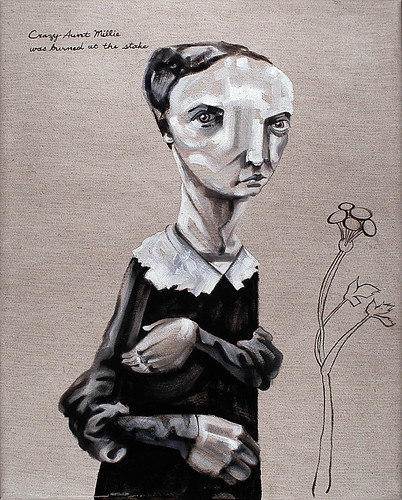
Crazy Aunt Millie (Was Burned at the Stake), oil on canvas, 2005. Click image to view source.
Do you have a favorite artist?
I have many. Here are some of my favorite artists of the moment: Joe Sorren (painter) Maira Kalman (painter, illustrator) Mike Disfarmer (photographer) August Sander (photographer) David Hughes (illustrator) James Jean (painter, illustrator) Ruth Ann Borum (painter, Norman, OK)
Where do you get your inspiration?
Inspiration comes from absolutely everywhere. Books, movies, music, magazines, internet. Right now I'm really excited by old signs for businesses around Oklahoma City. I especially love hand-painted signs. I'm often inspired by other artists: when I see a picture that I really like, I think to myself, "I want to do that, too!" So I may paint my own interpretation of that picture, in my own style.
As I mentioned, luck favors the prepared. I try and keep an open mind, and recognize that ideas can come from anywhere without warning.
Some Thoughts on Blogging: NaBloPoMo
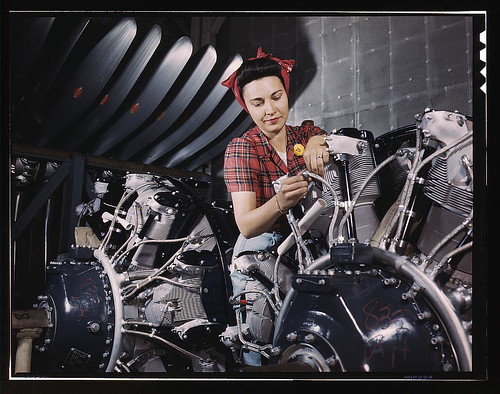
Woman working on an airplane motor at North American Aviation, Inc., plant in California. From the Library of Congress collection in the Flickr Commons. Click image to view source.
The curious abbreviation NaBloPoMo refers to National Blog Posting Month, which began a couple of years ago as a call for bloggers to post something every day for a month. (It's a spinoff of National Novel Writing Month.) Thanks to the efforts of people like Eden, NaBloPoMo is now celebrated every month of the year. There is a theme suggestion for each month, but blogging on the theme is always optional. It lives on as an exercise in developing the habit of regular blog posting.
I jumped on board NaBloPoMo for the month of July. It was a good time for me, as I had finished up work for my current solo show (Back to Normal at the Gaylord-Pickens Museum, through September 19). I always have more ideas than I have time to write about (or paint about), so I had a stack of blog topics saved up. I diligently released one post a day for three weeks. Then I stopped.
During those three weeks, I noticed my blogging behavior adapt like a small fish put into a bigger pond. The more blogging I did, the more topics I found worthy of blogging about. I could do it all day, every day. It was a rewarding experience, though limiting in other ways (my time, a valuable resource, was depleted).
Around the fourth week of July, daily blogging lost its importance for me. I had three shows open, my car had been totaled, etc etc; my blog slipped down my list of priorities. My readership had increased during daily posting (mostly via Facebook), but not dramatically. So I let myself off the hook.
I'll continue blogging, of course, but I don't plan to hold myself to a stringent timetable. Quality, not quantity. It's time for me to focus on being a painter, especially now that I have a new studio. Stay tuned.
Thank you, folks out in internetland, for reading this.
Found on Flickr: Okinawa Soba and Old Japan
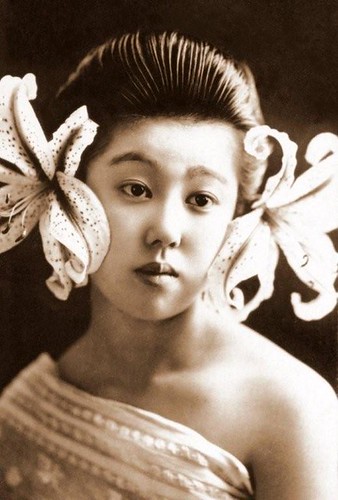
Geisha From Another World, vintage photograph posted by Flickr user Okinawa Soba. Click image to view source.
Flickr user Okinawa Soba has shared with us a vast archive of antique photographs, mostly of old Japan. If you have a couple of free hours, explore sets such as Geisha and Maiko, Religion in Old Japan, or Foot Binding in Old China.* (Caution -- some of these photographs contain nudity or are otherwise NSFW. Flickr will give you the option of viewing these, or not.) These photos are licensed under Creative Commons.
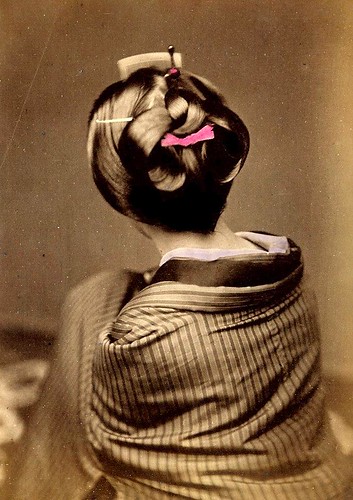
An Early Meiji-era Geisha Hair Style, vintage photograph posted by Flickr user Okinawa Soba. Click image to view source.
Okinawa Soba himself is quite a character, as you'll see from his humorous (though very informative) photo captions. (Many commenters provide additional information about the subjects photographed.) Read his full profile here.
Interestingly, there is a photo of Evelyn Nesbit (the "original supermodel" and inspiration for the Gibson Girl) posing as a geisha among this collection. OS thoughtfully provides a link to other Flickr images of Ms. Nesbit. We can see why she was such a big hit.
* If you're interested in the history of footbinding in China, I recommend Splendid Slippers: A Thousand Years of an Erotic Tradition
See what else I've Found on Flickr.
This post is part of NaBloPoMo for July 2009.
Andy Mattern, Photographer: Interview
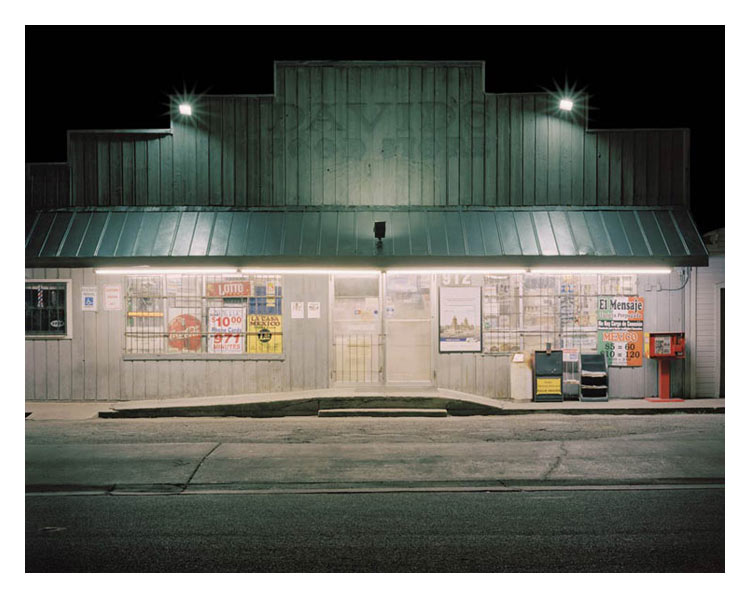
David's Food Store, 2005 photograph by Andy Mattern. Click here to see more images like this.
Andy Mattern is a photographer currently living in Minneapolis. His starkly composed images capture ordinary spaces of our lives as though human presence has been removed. In his work we feel absence and presence with equal weight.
I first met Andy when we went to high school together in Albuquerque, NM. I thought I'd check in and see what he's up to artistically these days.
SA: What kind of camera(s) are you currently using? Traditional film or digital?
AM: For the past few years, I have mainly worked with digital cameras, but I keep a 4x5 and a film cooler on hand just in case. The process of shooting digitally is frenetic and cerebral. I savor that speed and control, but I appreciate the meditative process of large format film, it's like a dream in slow motion. Part of the allure of photography is that there are all these choices of ways in which to work. It's easy to fetishize one method, but each has its benefits and, thankfully, it's not necessary to pick only one.
SA: Your technique is very formal. Is your composition entirely in-camera? Do you do any digital augmentation?
AM: I am not against cropping when necessary, but generally I compose in-camera. I spend a lot of time inspecting the edges and considering the frame as a whole before making a picture. Afterwards, if I notice something in the frame that shouldn't be there, I will remove or replace it. Working on a tripod and making numerous exposures lets me easily edit later.
SA: Why does formalism appeal to you over other techniques?
AM: Photography is an organizing tool for me. I use the camera to collect and consolidate my immediate environment into visual containers. I am not inclined to make abstract pictures because I am preoccupied with looking precisely at what is before me.
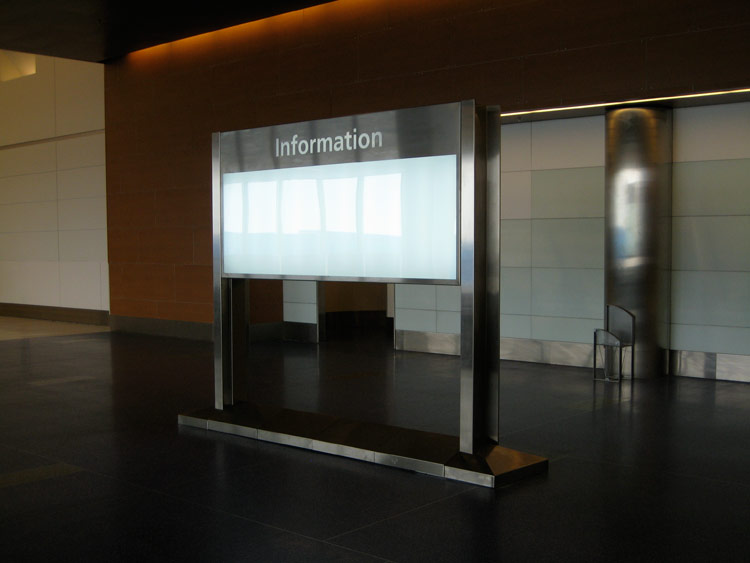
Information, 2009 photograph by Andy Mattern. Click here to see more images like this.
SA: How did you become an architectural photographer? Do you continue to do this as a business?
AM: I had been photographing buildings at night in Austin as a way to explore the new city for a few years when a photographer friend of mine referred me to an architect who needed a dusk shot of a new residence. I did the job and ended up getting more work by referral. In the lead up to graduate school, though, I have slowly tapered off my work. For the next three years I intend to focus my efforts on creative projects and teaching.
SA: What role has art played in your daily life in recent years?
AM: I am constantly stopping whatever I'm doing to make a picture. Whether it's with my tiny point-and-shoot camera, which I keep with me, or with one of my more official cameras, I get distracted by things I see and I can't relax until I photograph them.
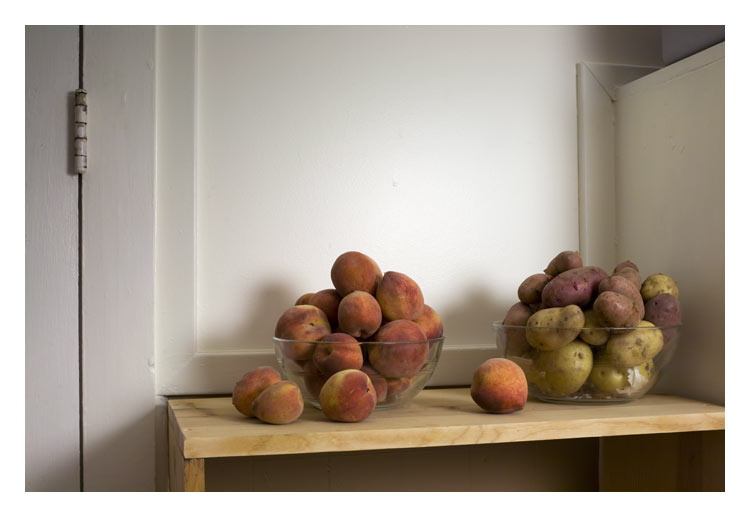
Peaches and Potatoes, 2008 photograph by Andy Mattern. Click here to see more images like this.
SA: The Leland St. series is photographs of your home (I presume). These photographs are less formal than much of your other work, yet they retain a detached, impersonal feel. What was the impetus for this series?
AM: A former professor of mine once said that if you are really good, you never have leave home to make pictures. Maybe Leland St. is an attempt to exercise that idea. As in my other series, I prefer to look directly at my subjects without distortion or visual inflection. I think it's interesting to take a step back and remove the actor from the scene in order to focus on the character of the place and provide room for new narratives to emerge. In the case of photographing my own space, a found a tension between this clinical way of seeing and depicting personal objects like toiletries and dishes. When I review these pictures, they appear to me like crime scene photographs or continuity images from a film set.
SA: You have just moved to Minneapolis. What will you be doing there?
AM: I am starting the MFA program at the University of Minnesota this fall.
SA: What are some of your current influences?
AM: I really like these books right now:
An American Index of the Hidden and Unfamiliar


I'm also taken with these artists: Cara Phillips Michael Vahrenwald Myoung Ho Lee Jake Rowland Dan Boardman
SA: Where can we see your work?
AM: I am always updating my website. But to see physical prints, please visit Stephen Clark Gallery in Austin, Texas. Also, I have a show coming up in Houston this November at the Lawndale Art Center.
---
This post is part of NaBloPoMo for July 2009.

